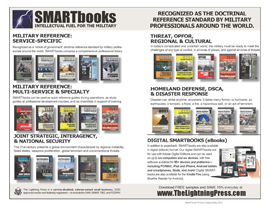Military Reference: Multi-Service & Specialty
Military Reference: Multi-Service & Specialty
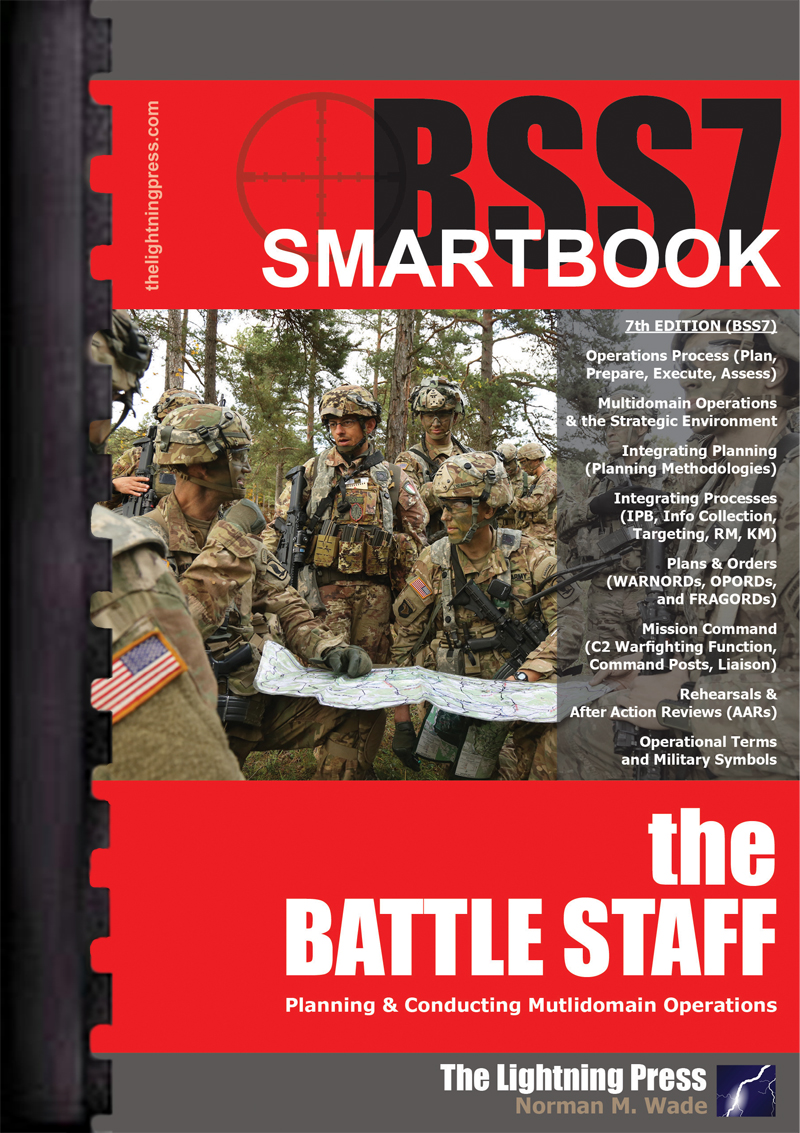
BSS7: The Battle Staff SMARTbook, 7th Ed.
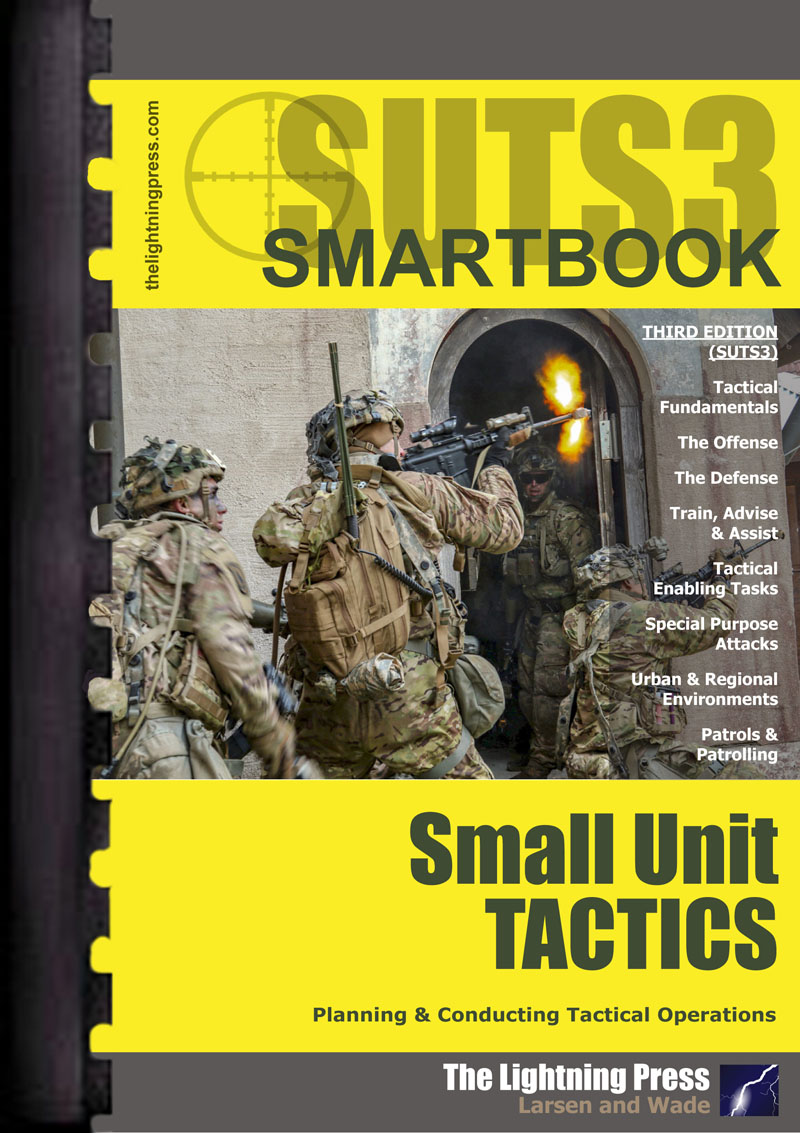
SUTS3: The Small Unit Tactics SMARTbook, 3rd Ed.
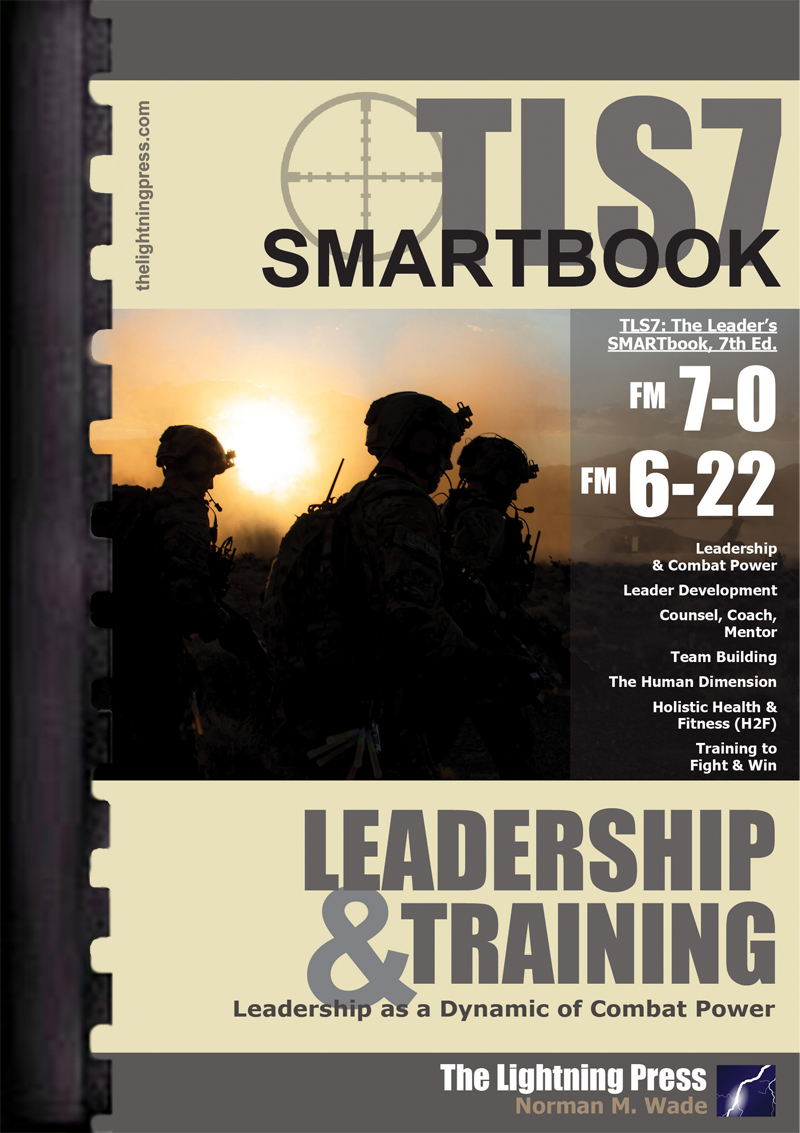
TLS7: The Leader’s SMARTbook, 7th Ed.
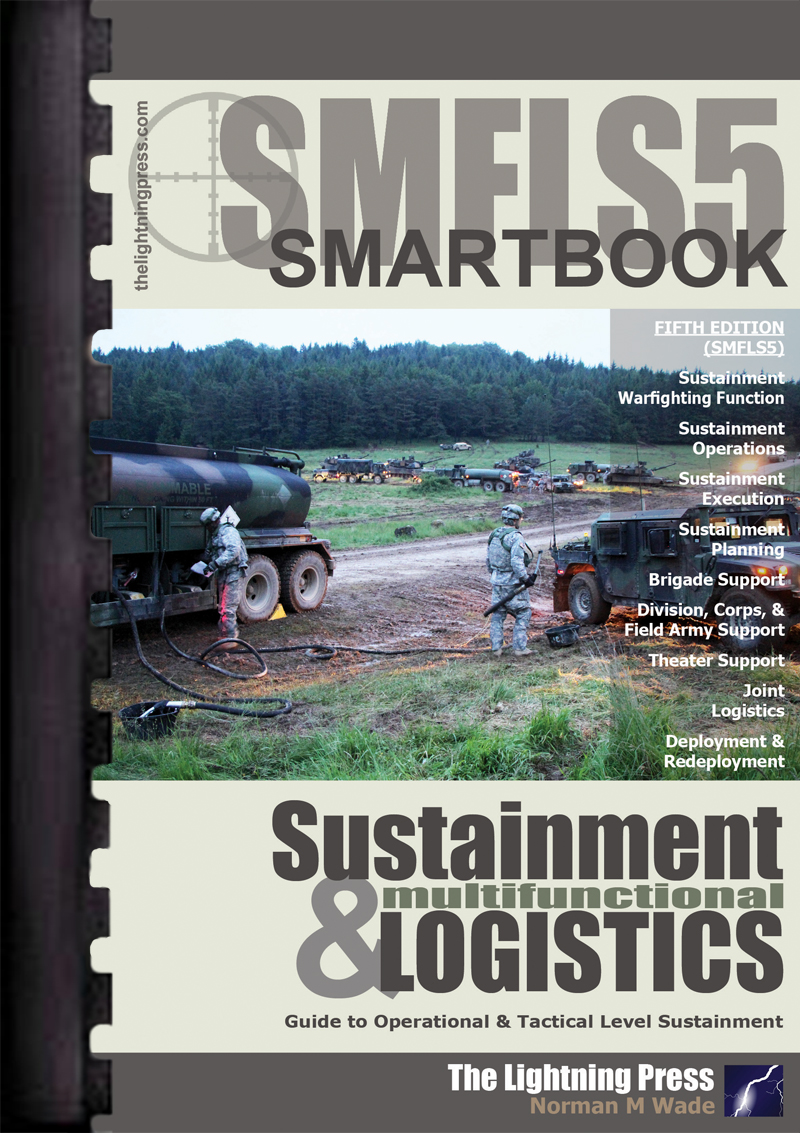
SMFLS5: The Sustainment & Multifunctional Logistics SMARTbook, 5th Ed.
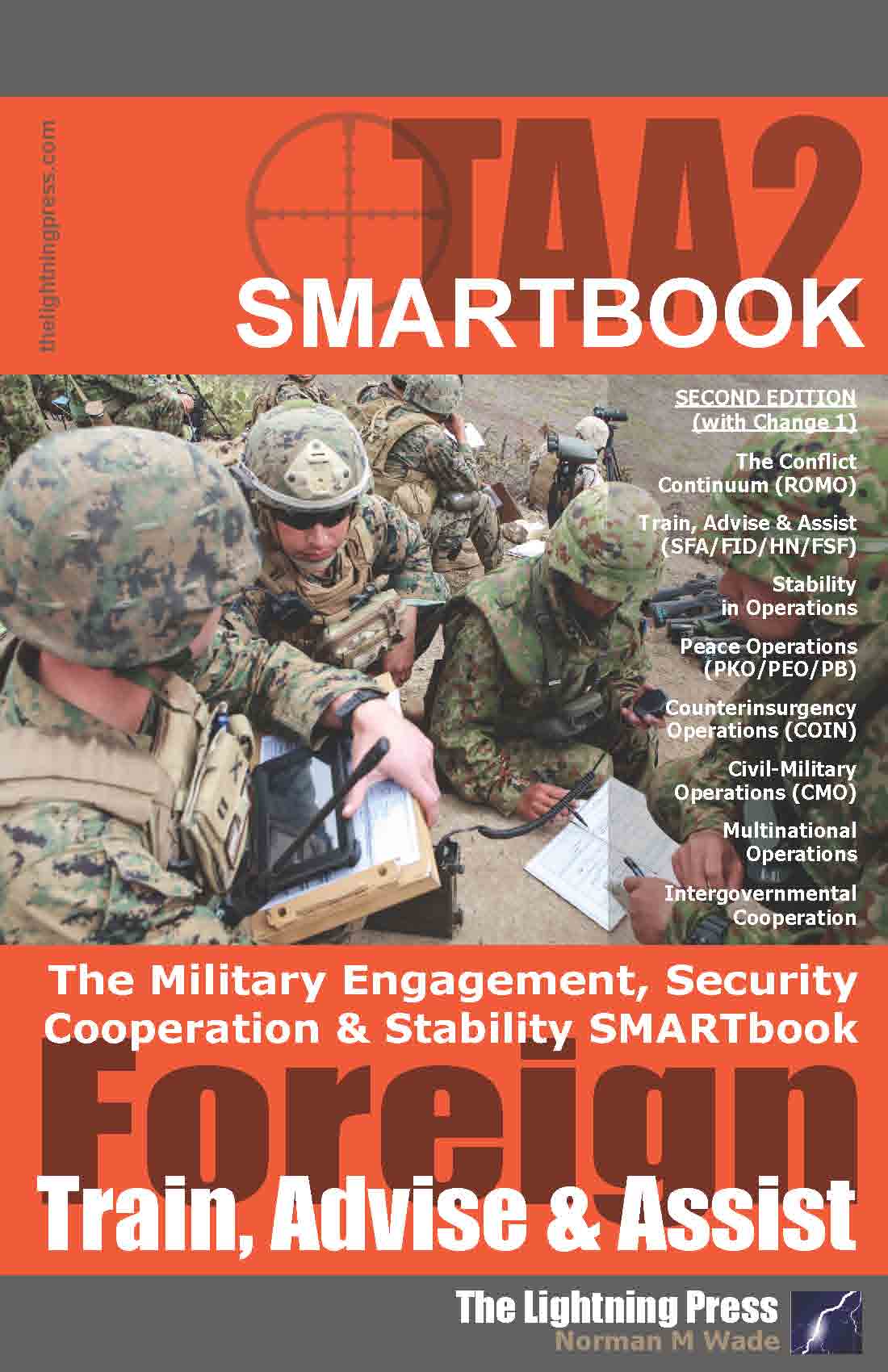
TAA2: The Military Engagement, Security Cooperation & Stability SMARTbook, 2nd Ed. (w/Change 1)
Military Reference: Service-level
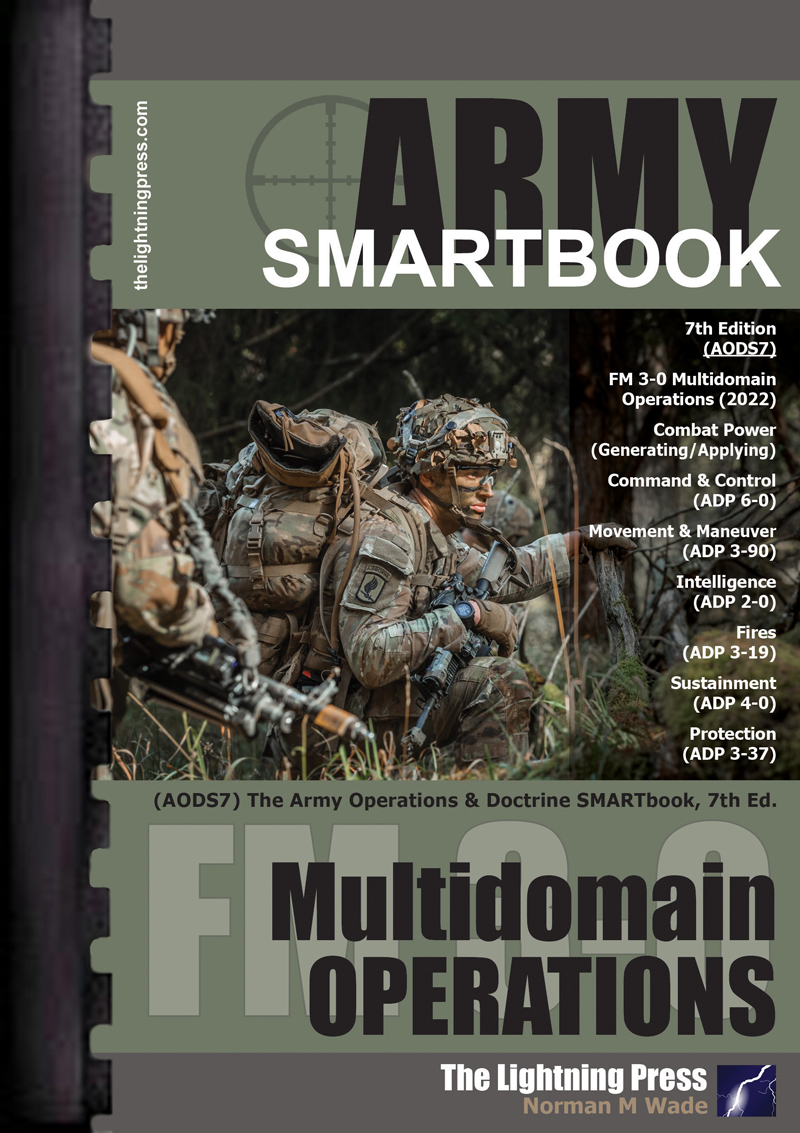
AODS7: The Army Operations & Doctrine SMARTbook, 7th Ed.
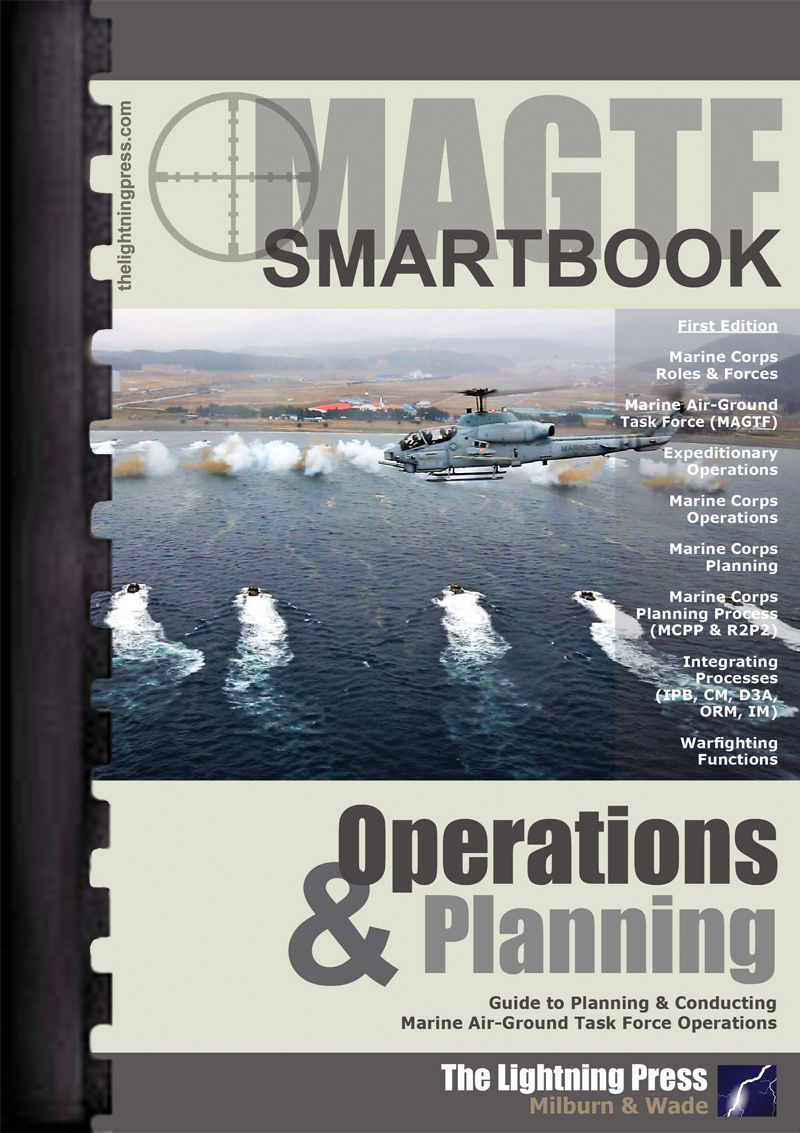
MAGTF: The MAGTF Operations & Planning SMARTbook
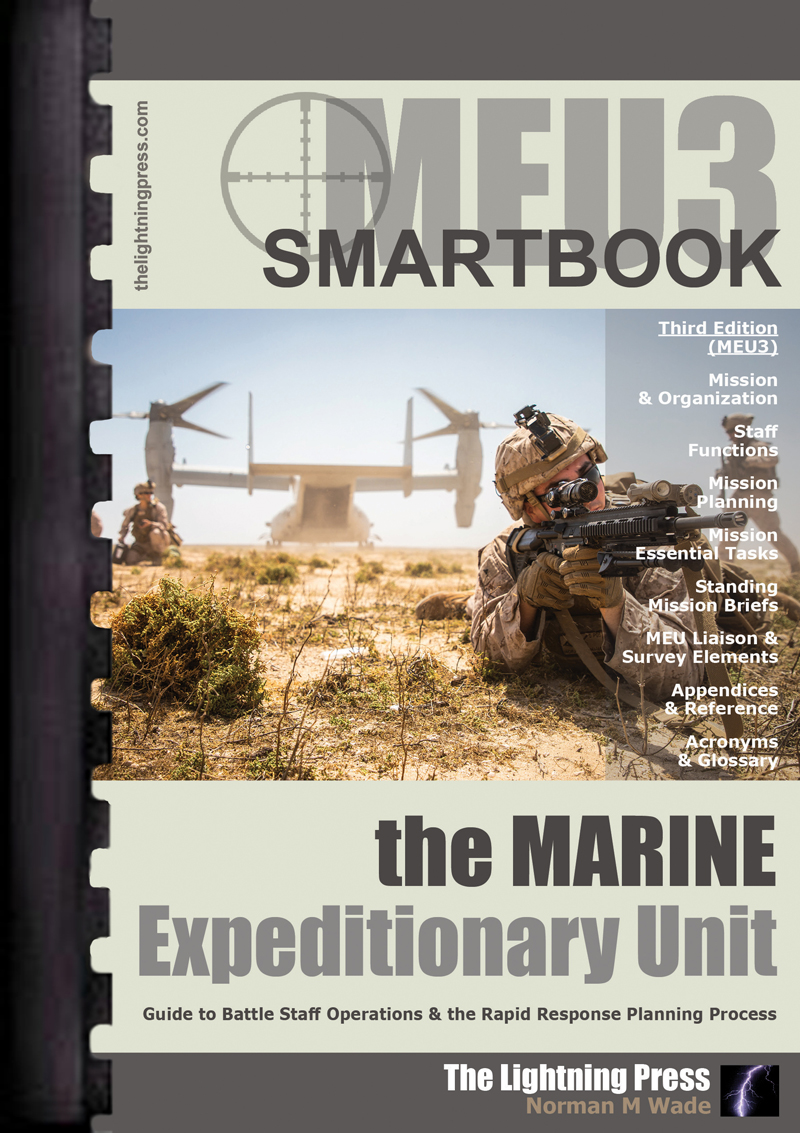
MEU3: The Marine Expeditionary Unit SMARTbook, 3rd Ed.
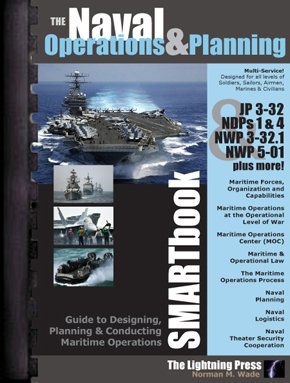
The Naval Operations & Planning SMARTbook
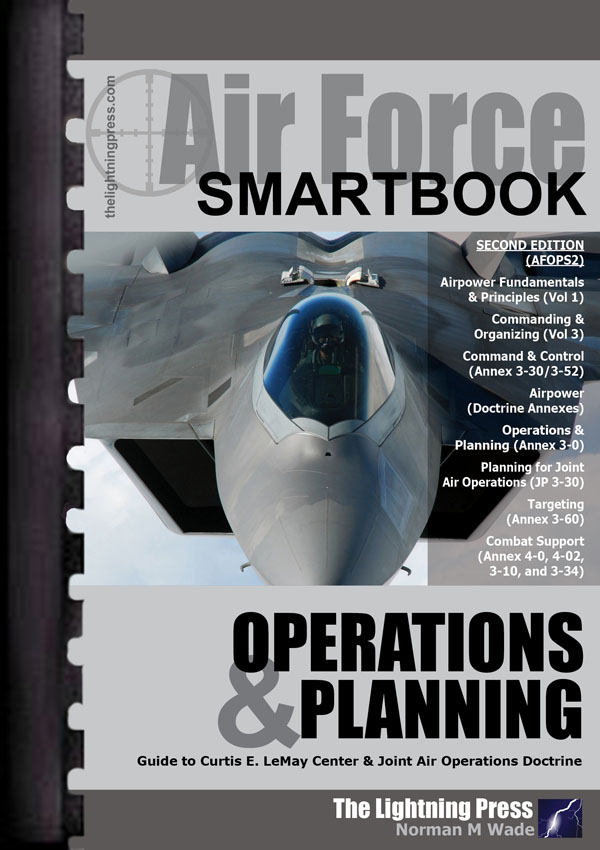
AFOPS2: The Air Force Operations & Planning SMARTbook, 2nd Ed.
Joint, Strategic, Interagency, & National Security
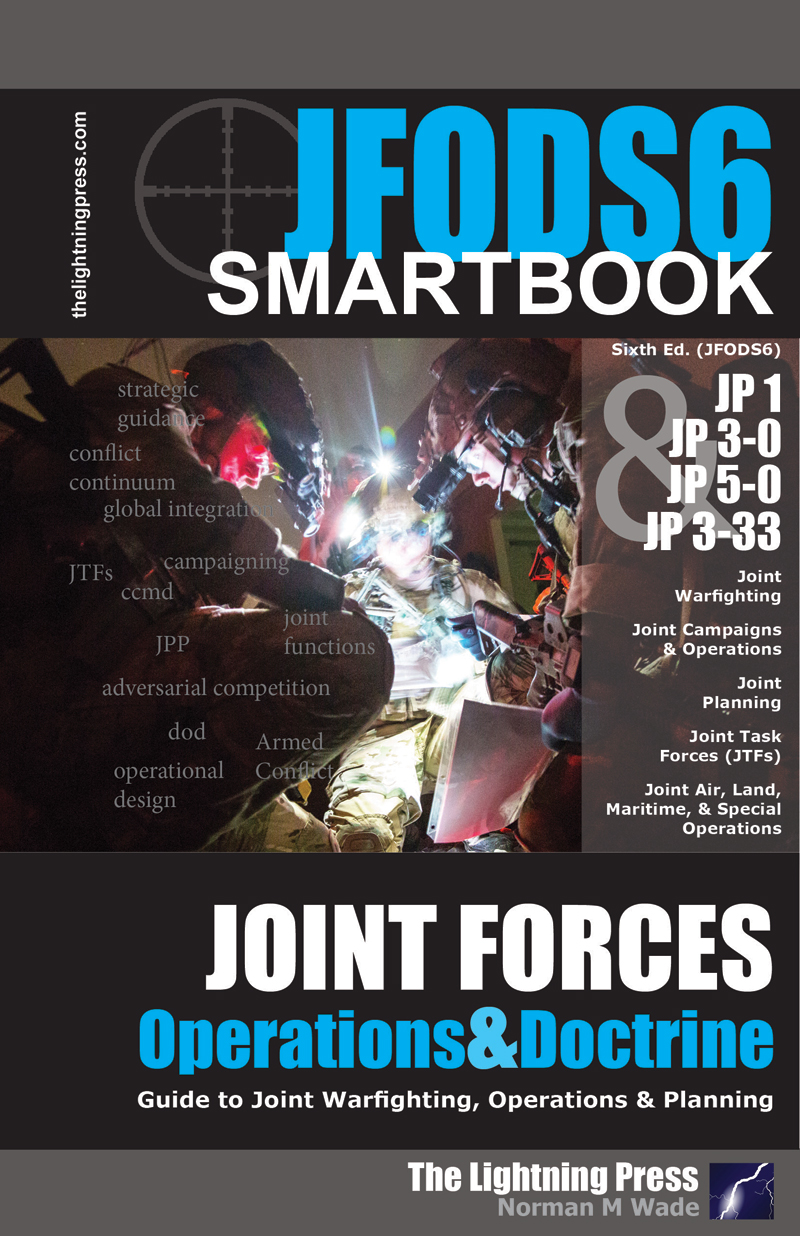
JFODS6: The Joint Forces Operations & Doctrine SMARTbook, 6th Ed.
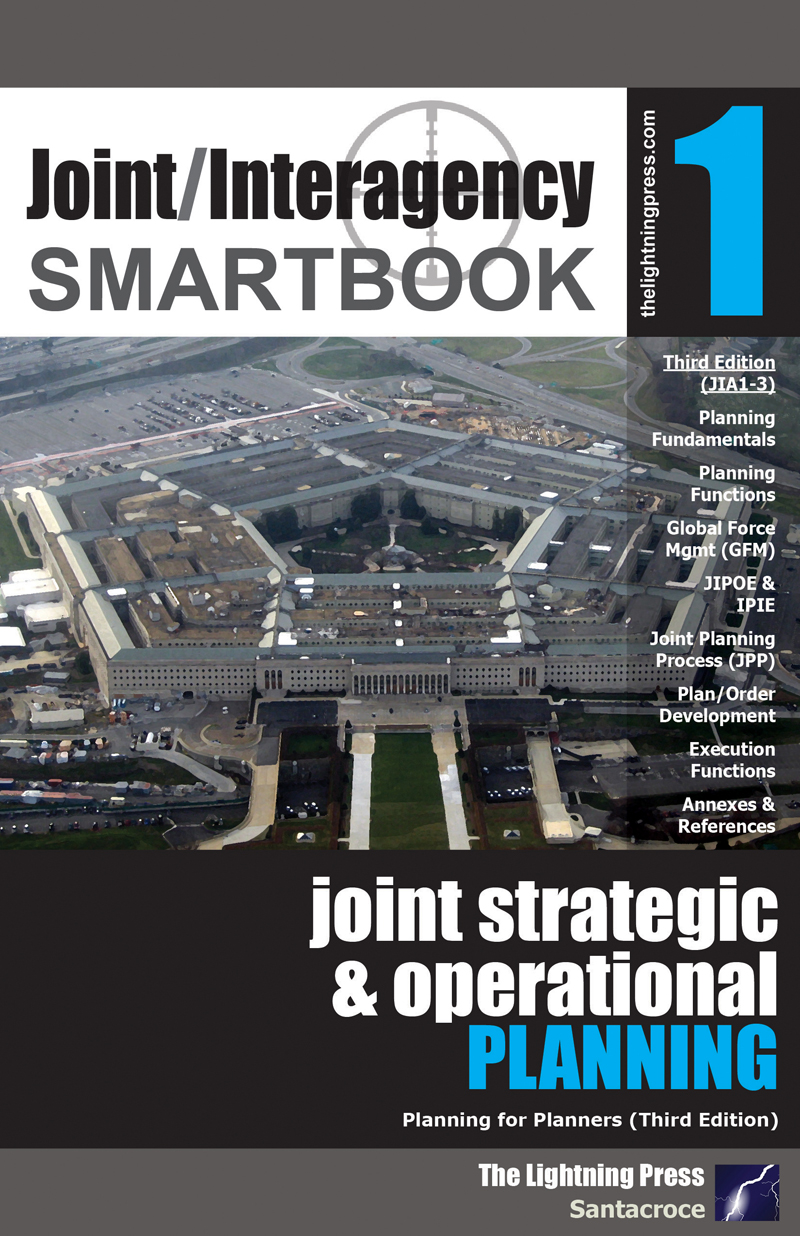
Joint/Interagency SMARTbook 1 – Joint Strategic & Operational Planning, 3rd Ed.
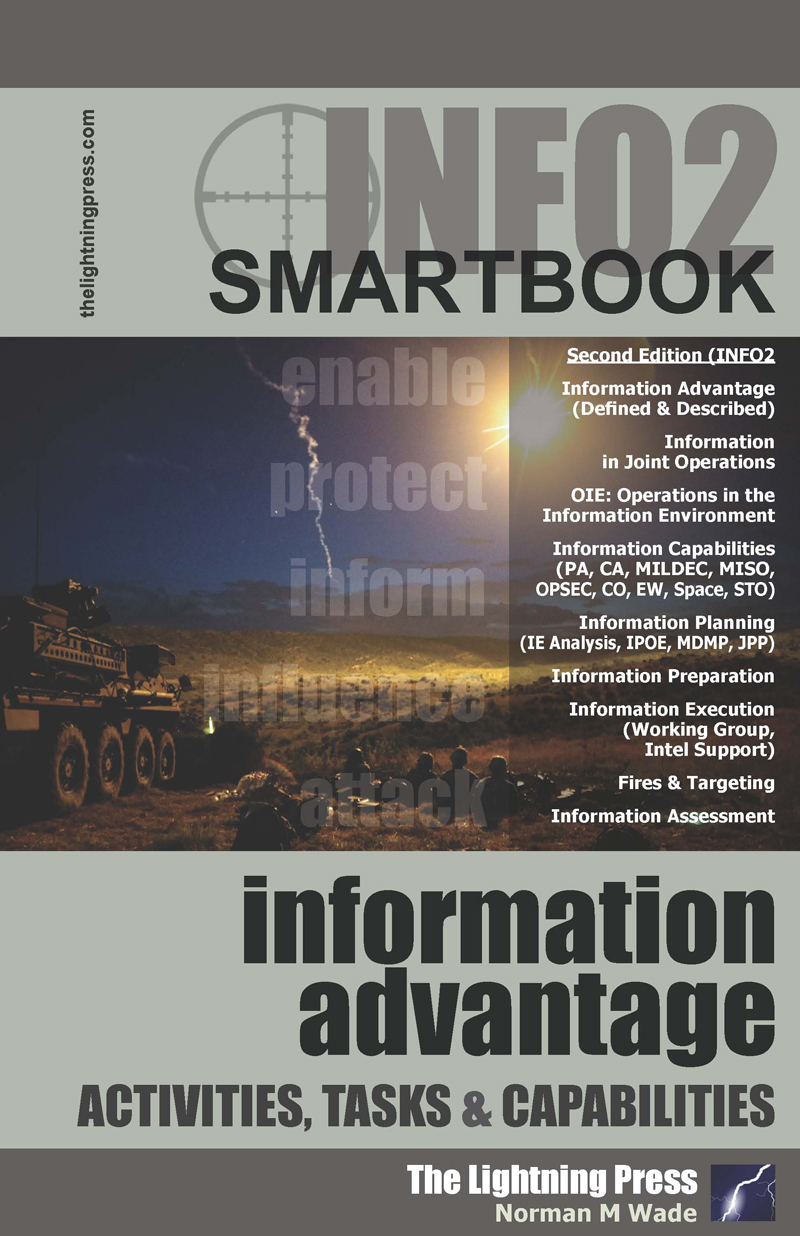
INFO2 SMARTbook: Information Advantage
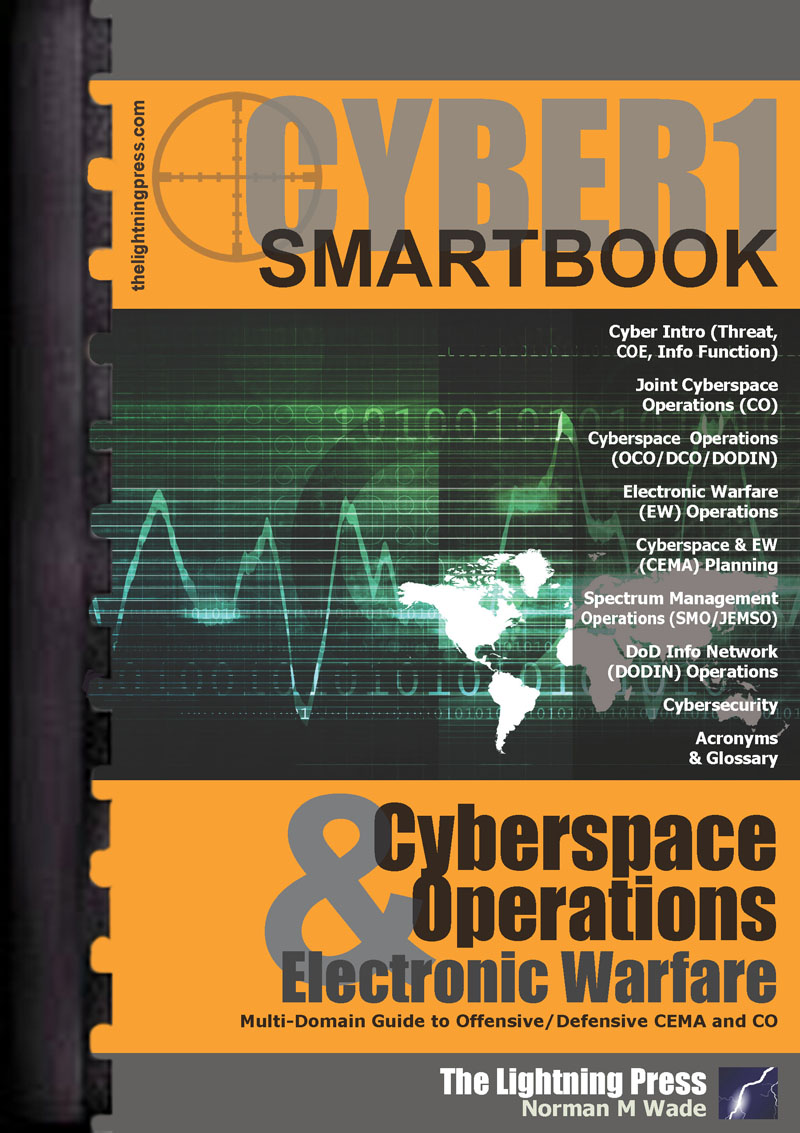
CYBER1-1: The Cyberspace Operations & Electronic Warfare SMARTbook (w/SMARTupdate 1)
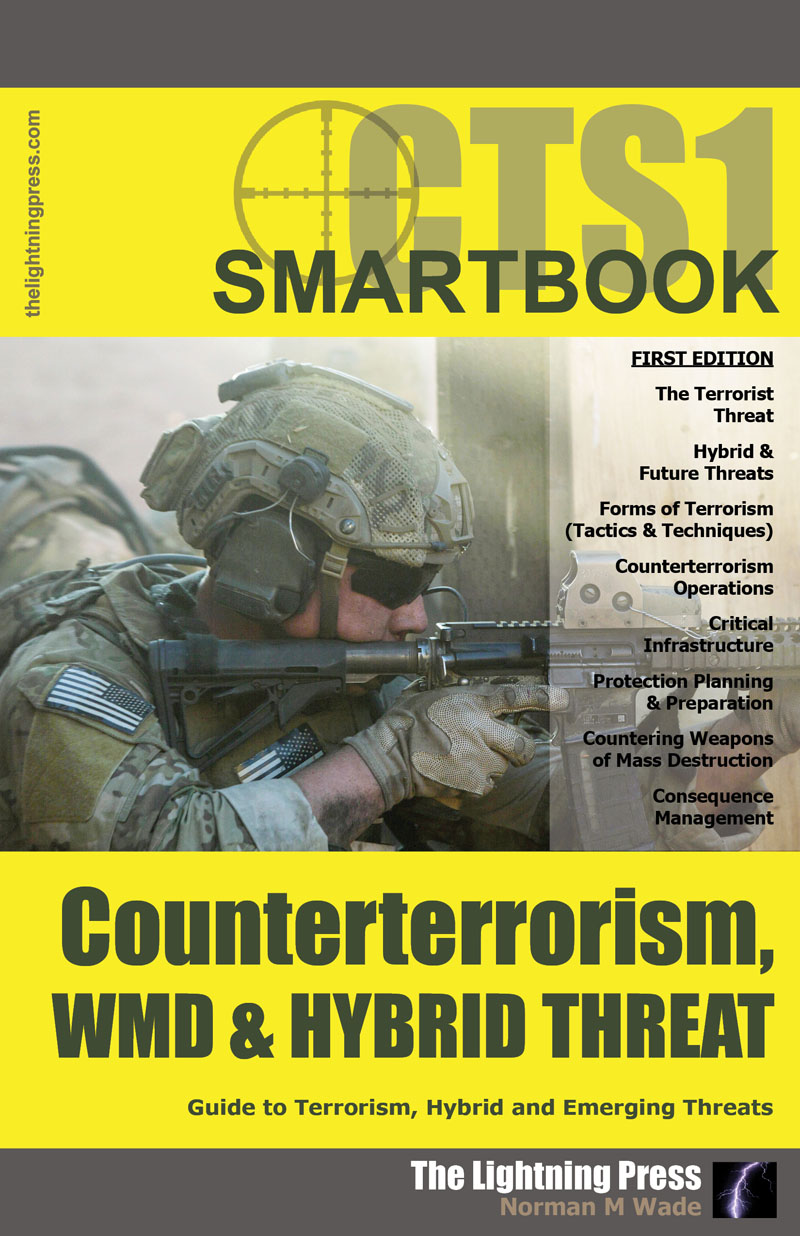
CTS1: The Counterterrorism, WMD & Hybrid Threat SMARTbook
Threat, OPFOR, Regional & Cultural
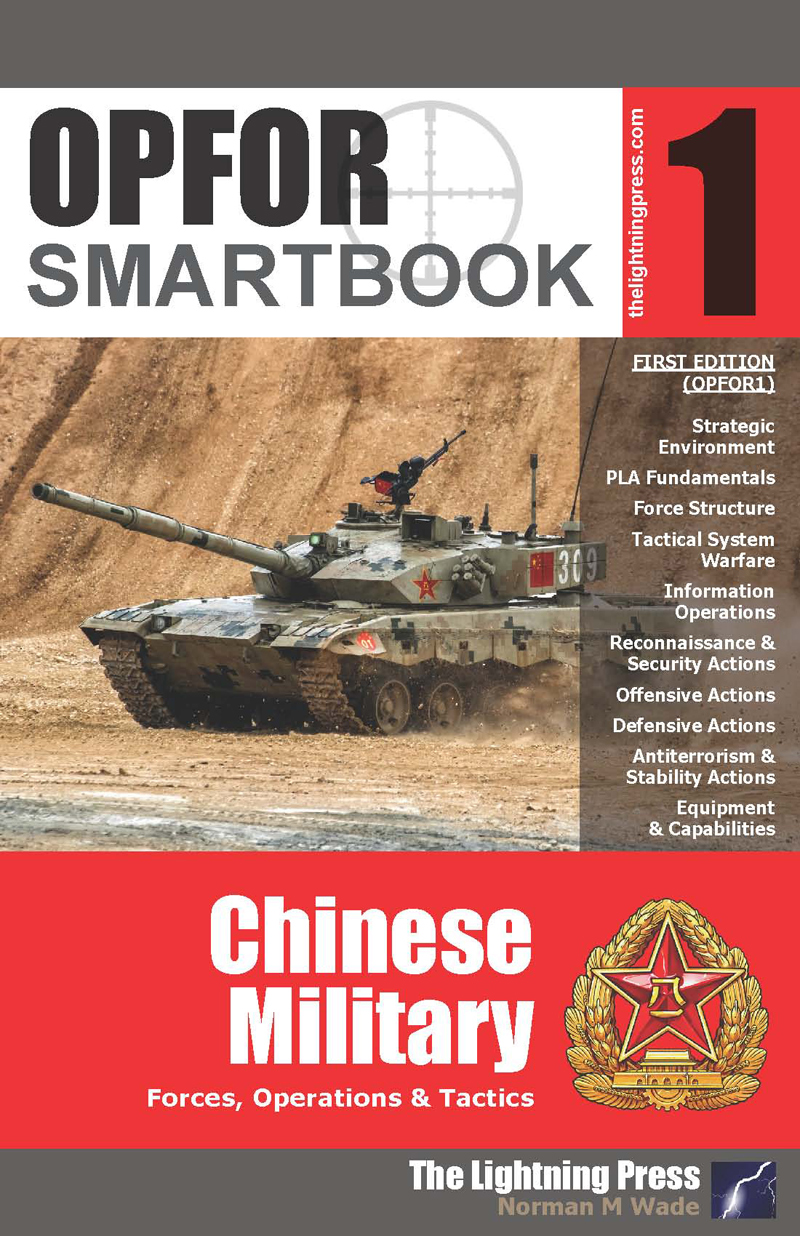
OPFOR SMARTbook 1 - Chinese Military
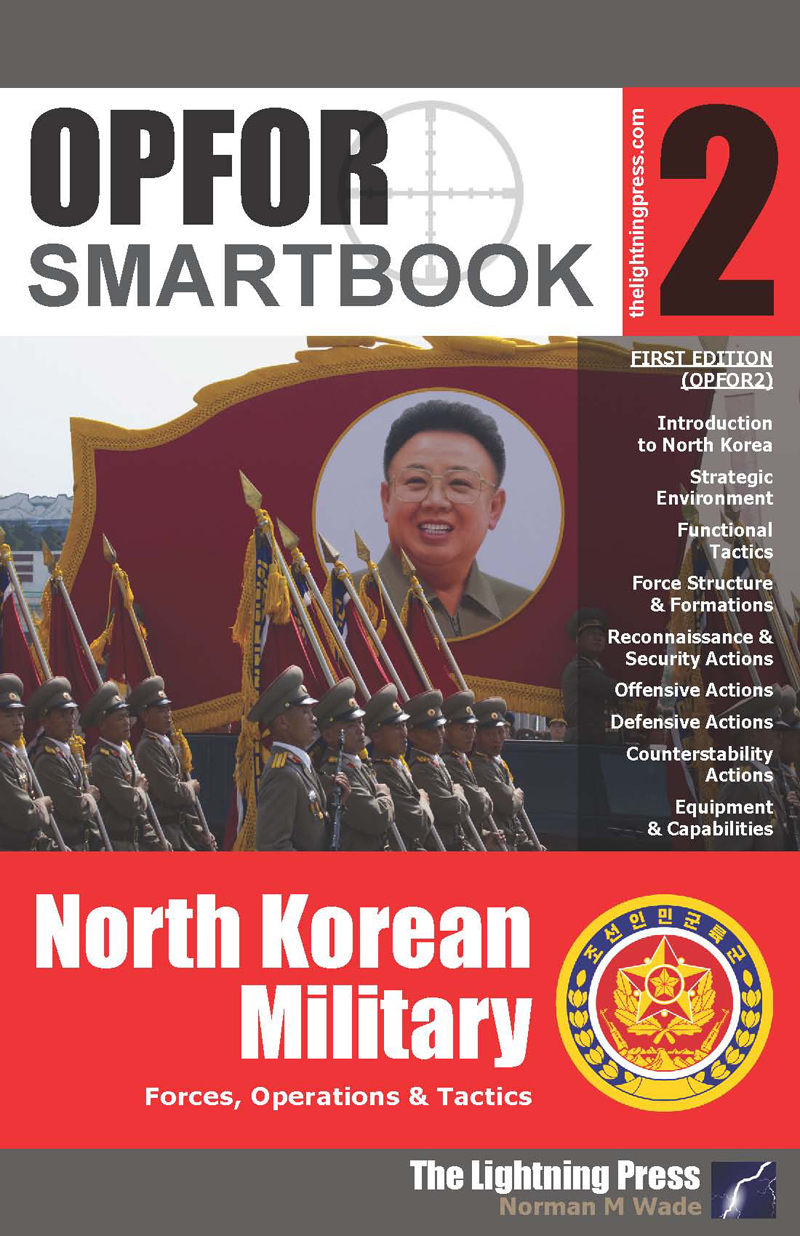
OPFOR SMARTbook 2 - North Korean Military
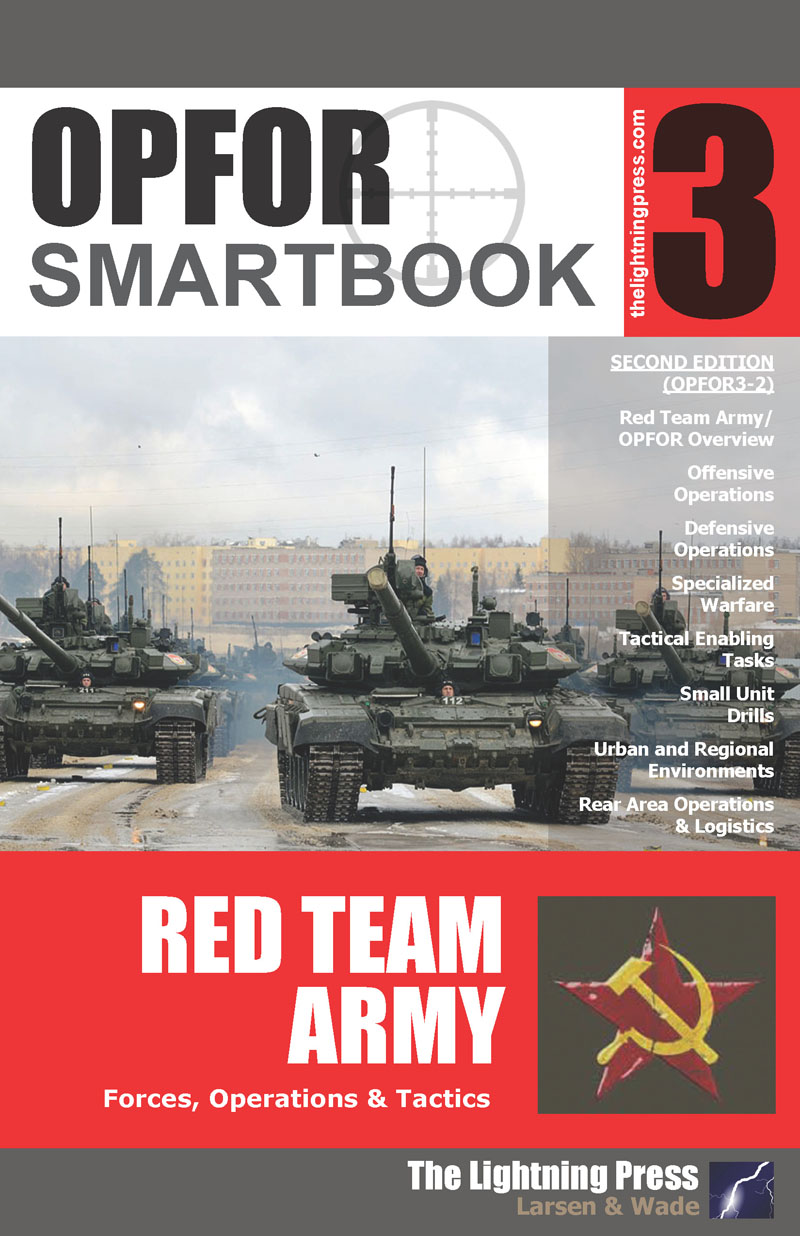
OPFOR SMARTbook 3 - Red Team Army, 2nd Ed.
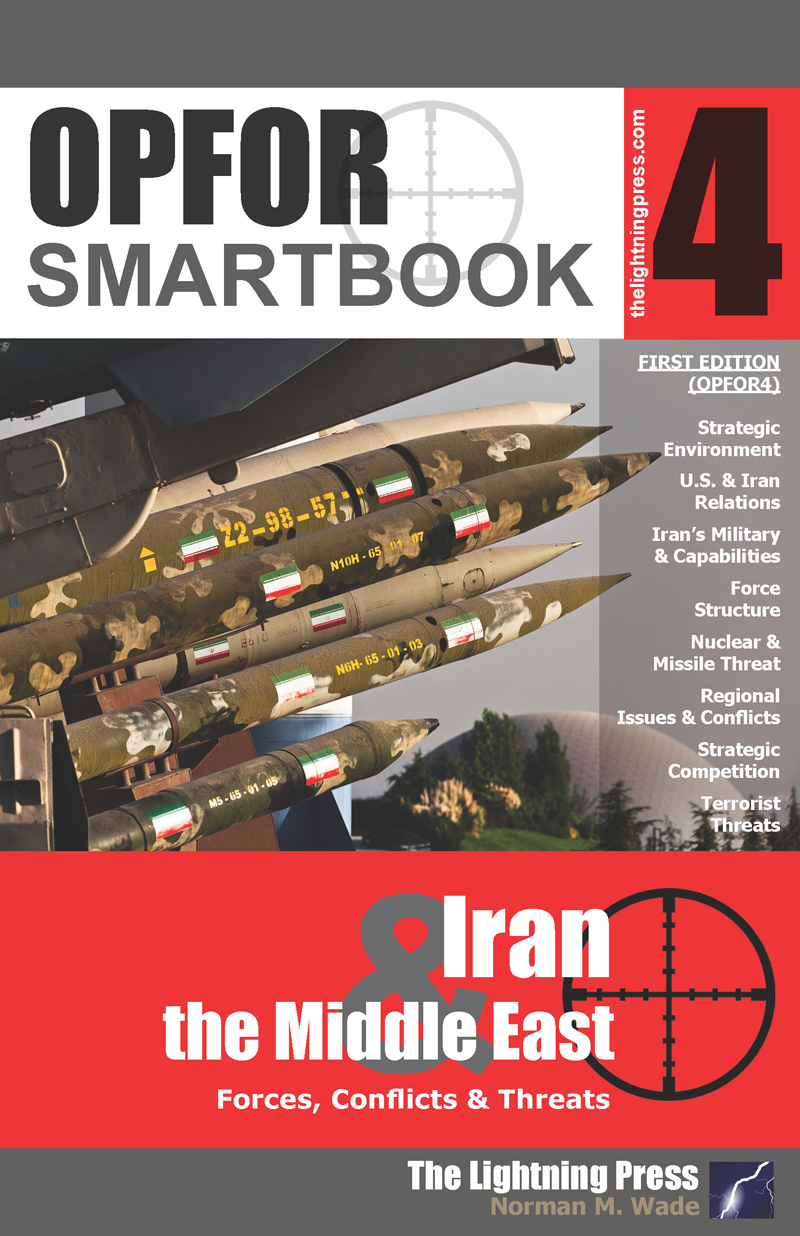
OPFOR SMARTbook 4 - Iran & the Middle East
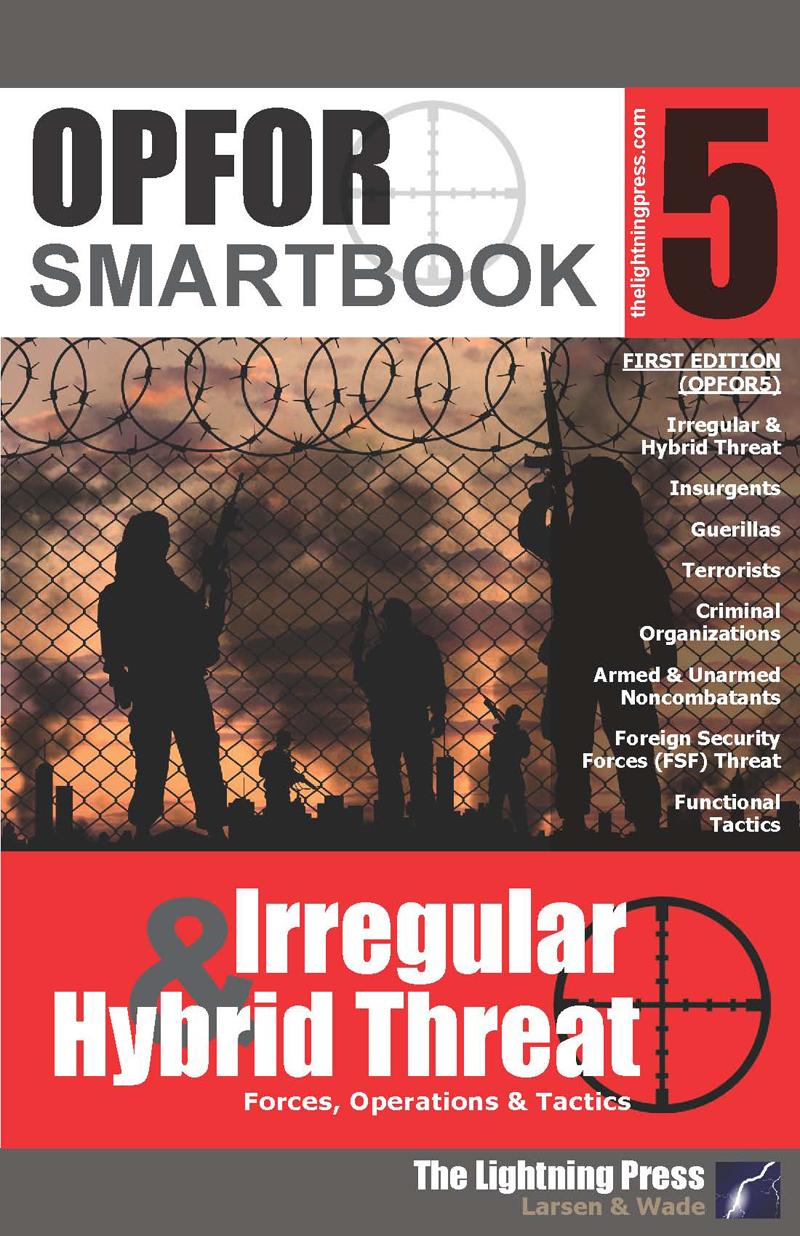
OPFOR SMARTbook 5 - Irregular & Hybrid Threat
Homeland Defense, DSCA, & Disaster Response
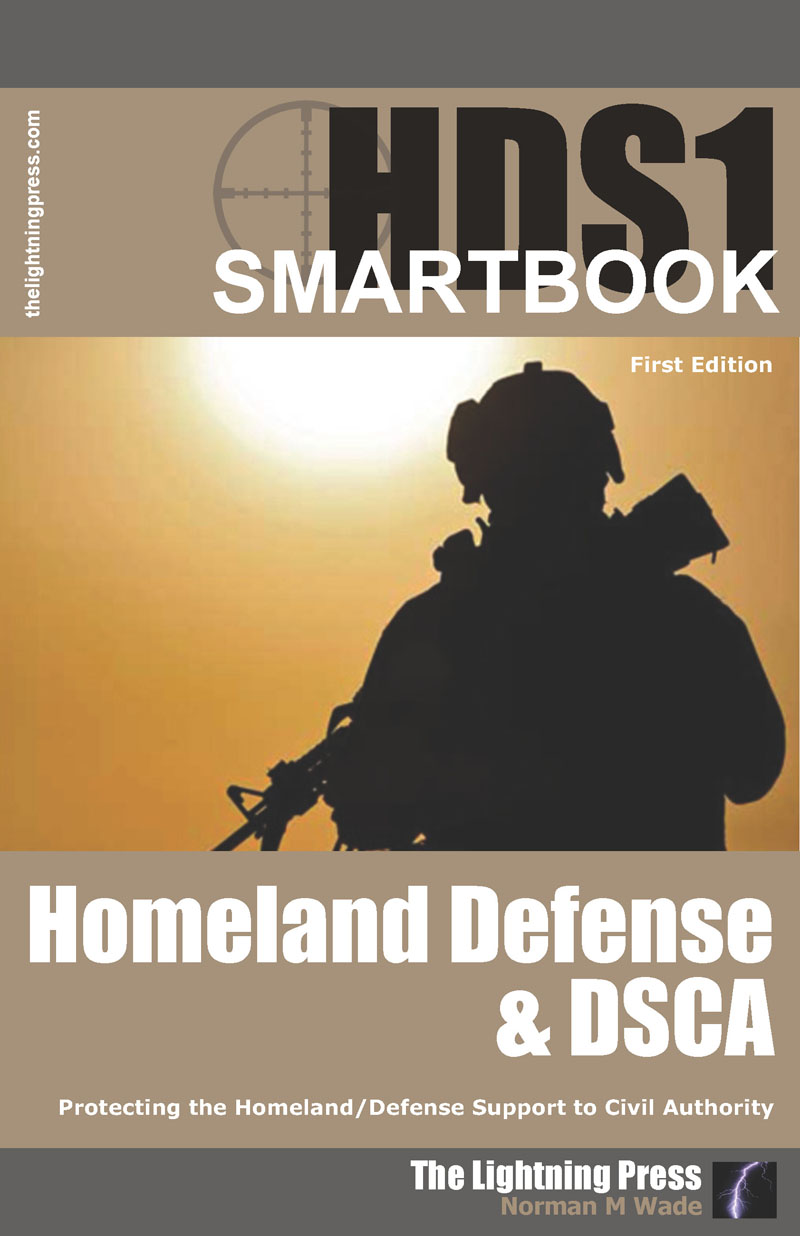
HDS1: The Homeland Defense & DSCA SMARTbook
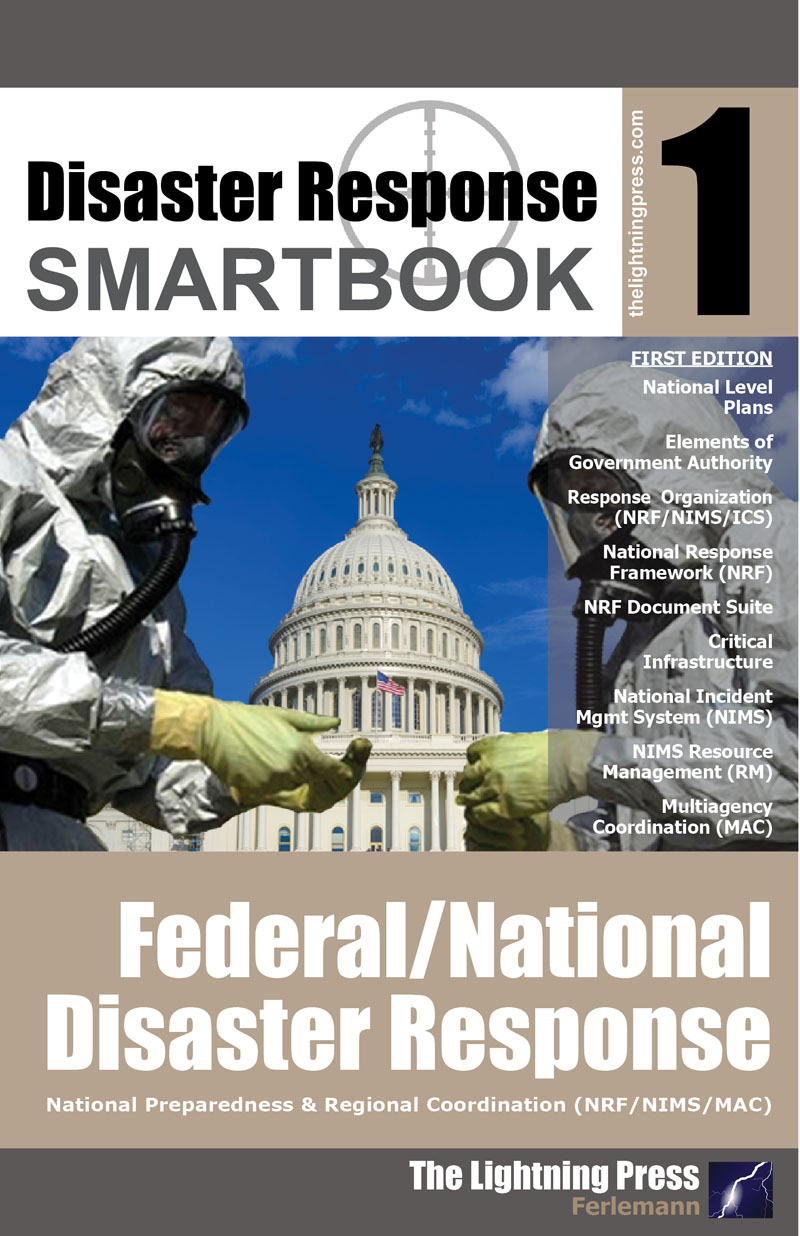
Disaster Response SMARTbook 1 – Federal/National Disaster Response
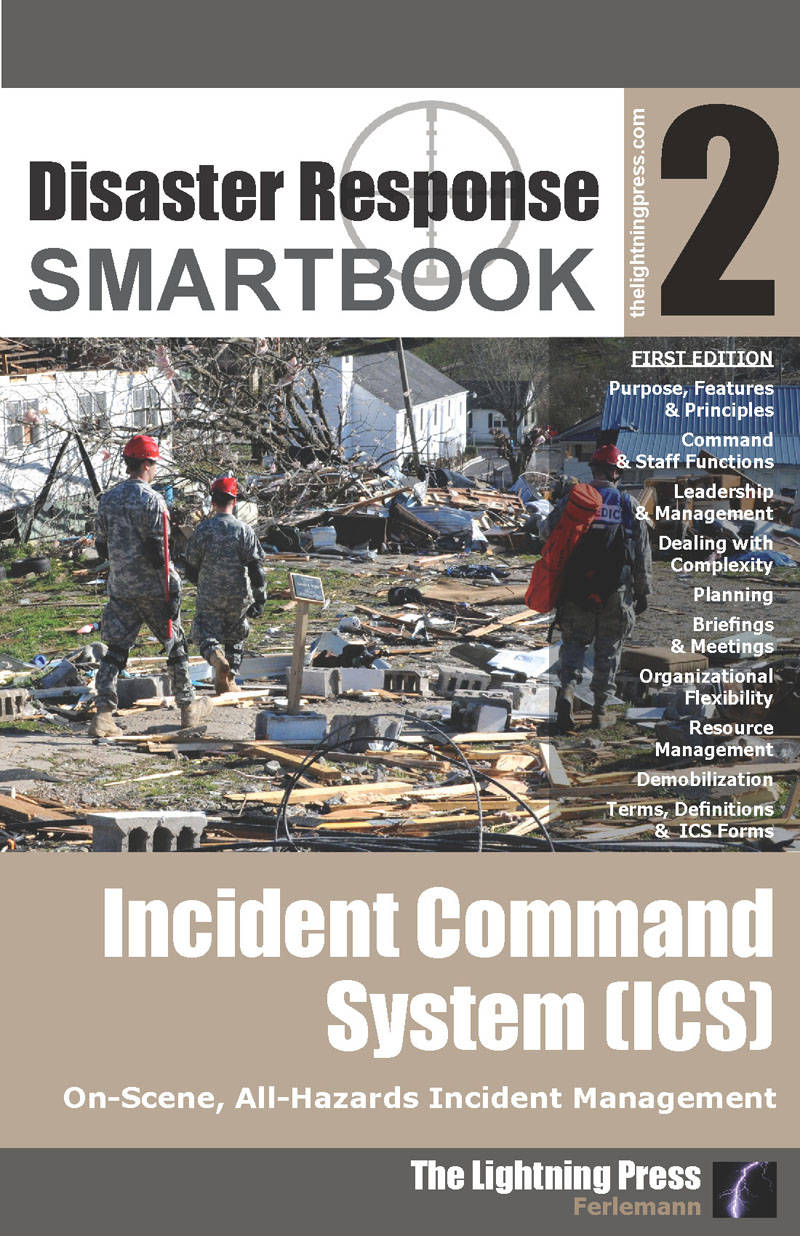
Disaster Response SMARTbook 2 – Incident Command System (ICS)
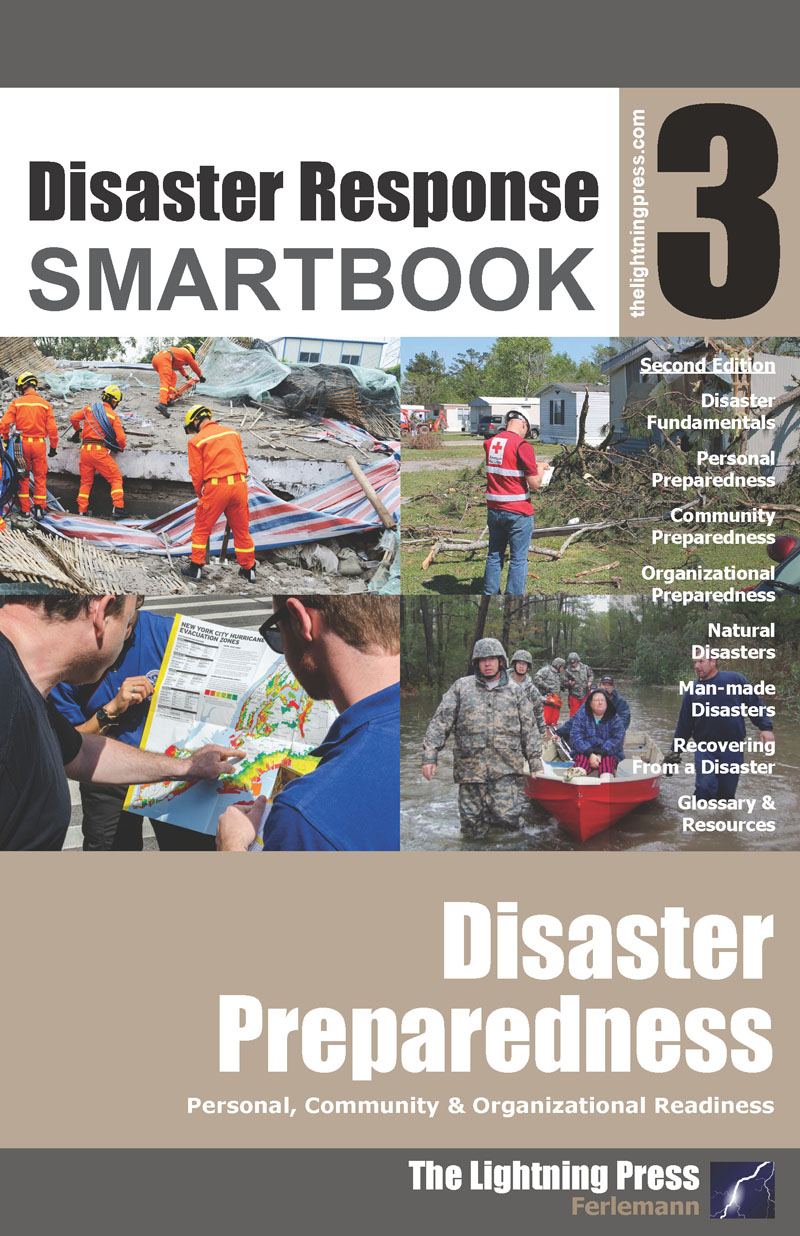
Disaster Response SMARTbook 3 - Disaster Preparedness, 2nd Ed.

CYBER1-1: The Cyberspace Operations & Electronic Warfare SMARTbook (w/SMARTupdate 1)
SMARTupdates
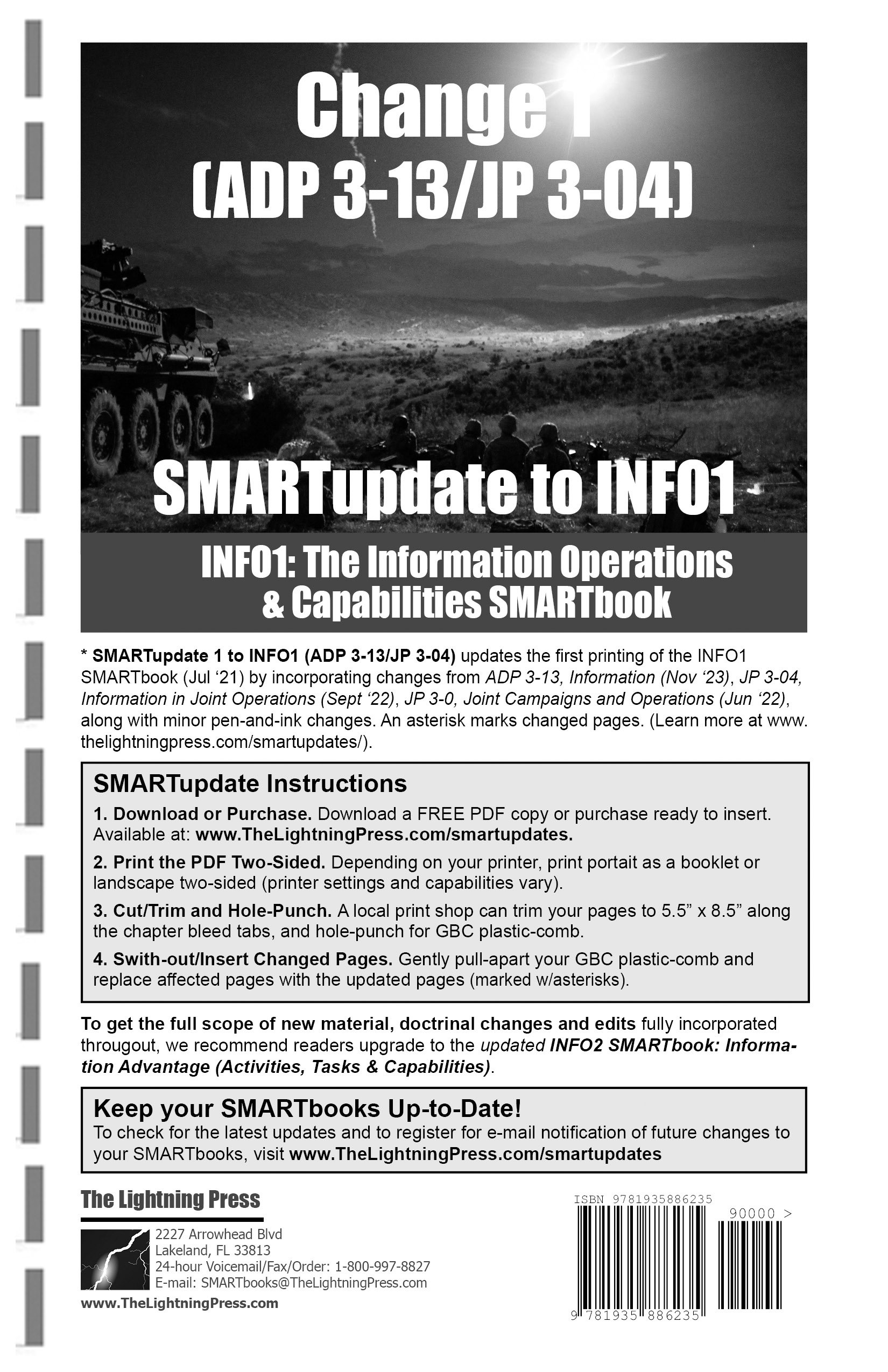
Change 1 (ADP 3-13/JP 3-04) SMARTupdate to INFO1
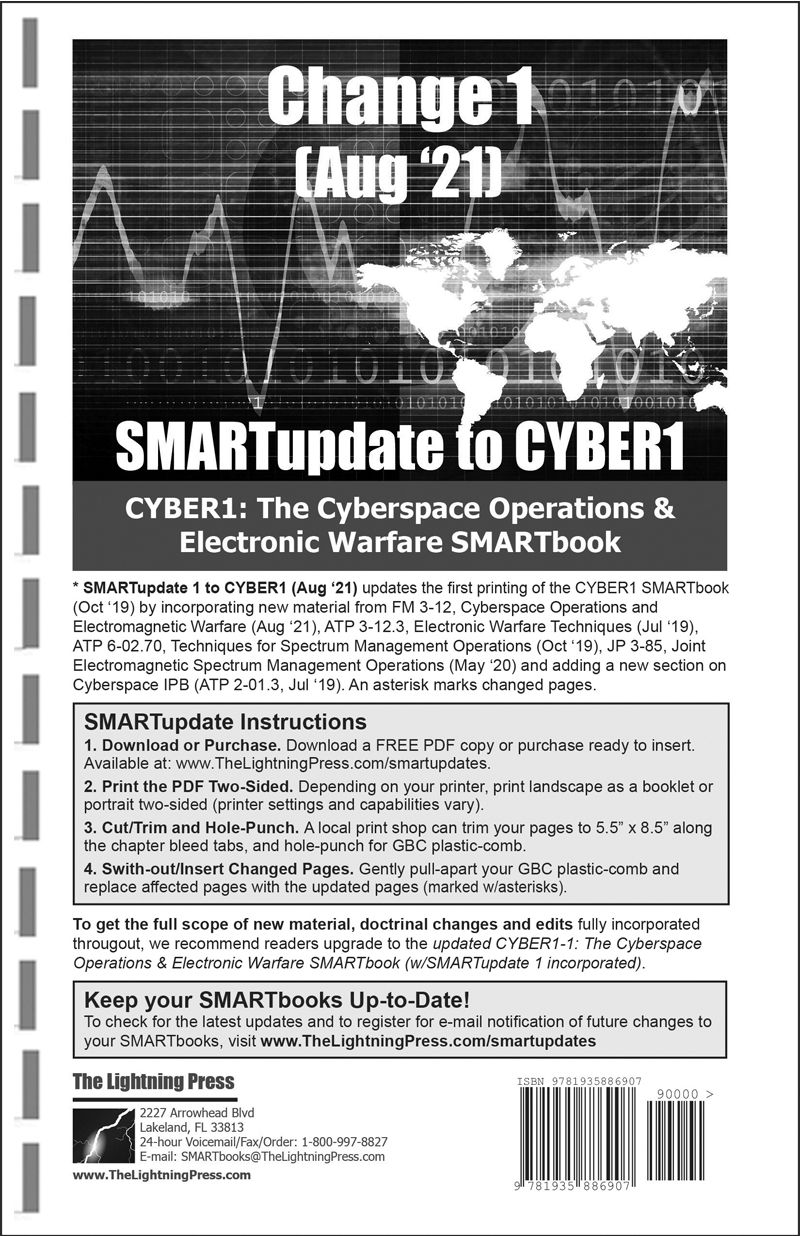
Change 1 (Aug ‘21) SMARTupdate to CYBER1
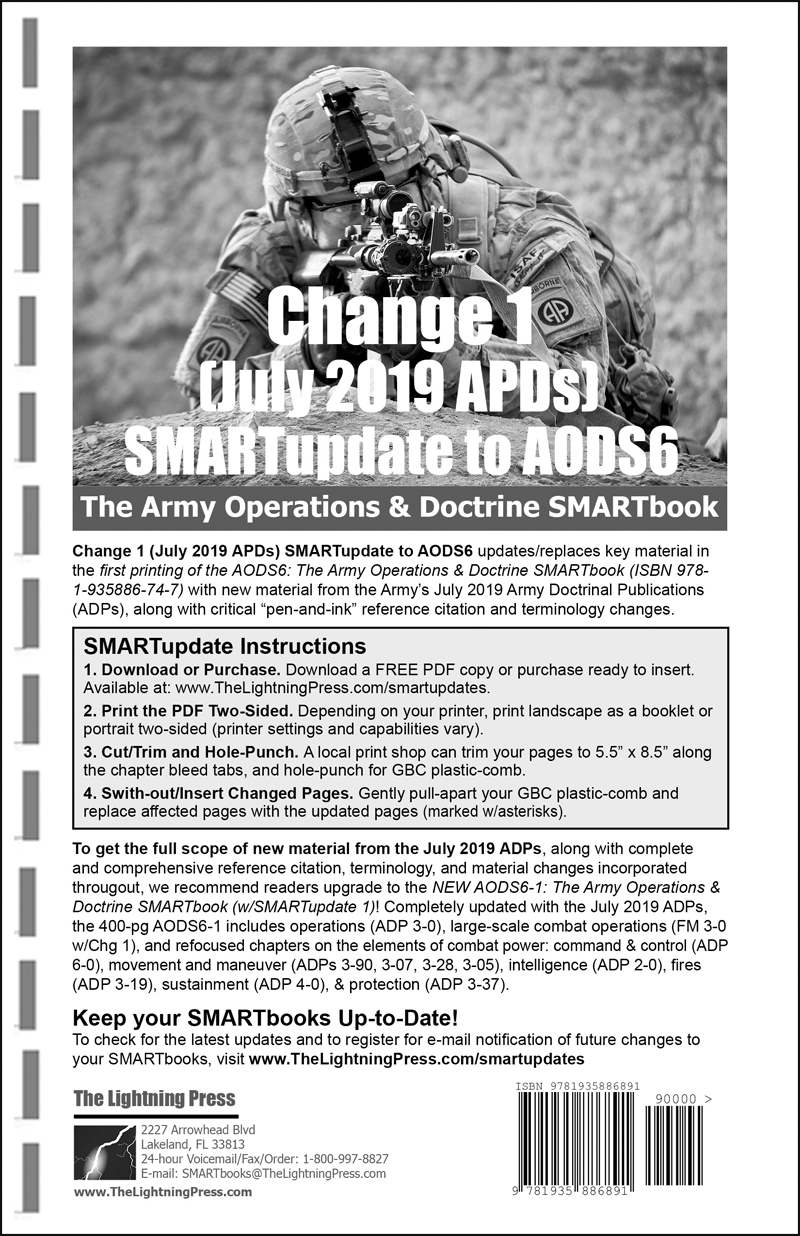
Change 1 (July 2019 ADPs) SMARTupdate to AODS6
Books in Development
SMARTsets
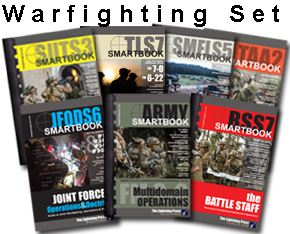
The ''WARFIGHTING'' SUPERset (7 books)
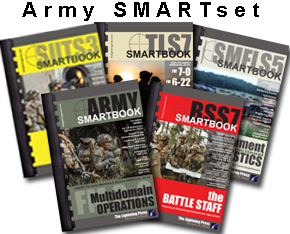
The ''ARMY'' SMARTset (5 books)
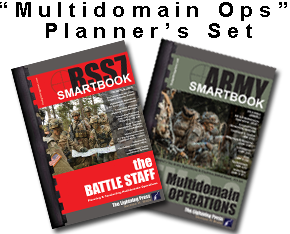
''Multidomain Operations'' Planner's SMARTset (2 books)
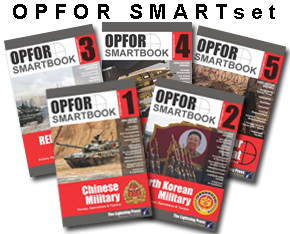
The ''OPFOR THREAT'' SMARTset (5 books)
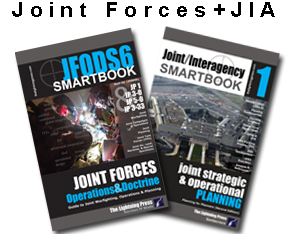
The ''JOINT FORCES + JOINT/INTERAGENCY'' SMARTset (2 books)

The ''INFO + CYBER'' SMARTset (2 books)
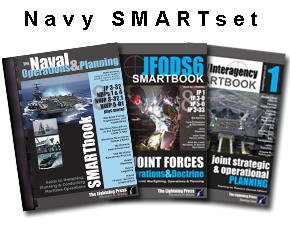
The ''NAVY'' SMARTset (3 books)
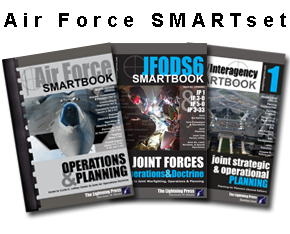
The ''AIR FORCE'' SMARTset (3 books)
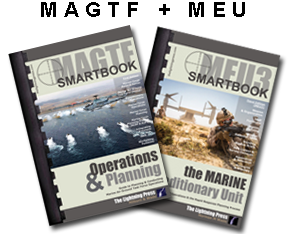
The ''MAGTF + MEU'' SMARTset (2 books)
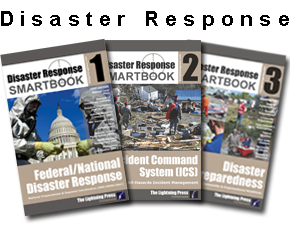
The ''DISASTER RESPONSE'' SMARTset (3 books)
BSS7: The Battle Staff SMARTbook, 7th Ed.
ISBN-10 :1-935886-94-0
Release Date :Oct 1st, 2023
Norman M. Wade
Binding Type:Plastic Comb
Print Inside Pages:Black and White
Trim Size:5.5'' x 8.5''
Total Pages:360

Paperback Edition
Price: $42.95 $36.95

Bundle & Save (Paperback + Digital)
Price: $85.90 $49.95
Planning & Conducting Multidomain Operations
BSS7: The Battle Staff SMARTbook, 7th Ed. is completely updated for 2023 to include FM 5-0 w/C1, Planning and Orders Production (2022); FM 6-0, Commander and Staff Organization and Operations (2022), FMs 1-02.1/.2, Military Terms & Symbols (2022); and more!
Focusing on planning and conducting multidomain operations (FM 3-0 Operations, 2022), BSS7 covers the operations process; commander and staff activities; the five Army planning methodologies - Army Design Methodology (ADM), Military Decison-making Process (MDMP), Troop Leading Procedures (TLP), Rapid Decision-Making and Synchronization Process (RDSP), & Army Problem Solving; integrating processes (IPB, information collection, targeting, risk management, and knowledge management); plans and orders; mission command, C2 warfighting function tasks, command posts, liaison; rehearsals & after action reviews; and operational terms and military symbols.
The Army’s framework for organizing and putting command and control into action is the operations process—the major command and control activities performed during operations: planning, preparing, executing, and continuously assessing the operation. Commanders use the operations process to drive the conceptual and detailed planning necessary to understand their operational environment (OE); visualize and describe the operation’s end state and operational approach; make and articulate decisions; and direct, lead, and assess operations.
Commanders, staffs, and subordinate headquarters employ the operations process to organize efforts, integrate the warfighting functions across multiple domains, and synchronize forces to accomplish missions. This includes integrating numerous processes and activities within the headquarters and with higher, subordinate, supporting, and supported units. Key integrating processes that occur throughout the operations process include intelligence preparation of the battlefield, information collection, targeting, risk management, and knowledge management.
Planning requires the integration of both conceptual thinking and detailed analysis. Army leaders employ several methodologies for planning, determining the appropriate mix based on the scope and understanding of the problem, time available, and availability of a staff. Army planning methodologies include the Army design methodology (ADM), military decision-making process (MDMP), Troop leading procedures (TLP), rapid decision-making and synchronization process (RDSP),and Army problem solving.
Commanders and staffs integrate the warfighting functions and synchronize the force to adapt to changing circumstances throughout the operations process. They use several integrating processes to do this. An integrating process consists of a series of steps that incorporate multiple disciplines to achieve a specific end. For example, during planning, the military decision-making process (MDMP) integrates the commander and staff in a series of steps to produce a plan or order. Key integrating processes that occur throughout the operations process include intelligence preparation of the battlefield, information collection, targeting, risk management, and knowledge management.
Note: BSS7: The Battle Staff SMARTbook, 7th Ed. is designed specifically to work hand-in-hand as a planner’s companion guide to AODS7: The Army Operations & Doctrine SMARTbook (Multidomain Operations), with specific page references that lead to expanded content pertinent to understanding multidomain operations from FM 3-0. Save $14.90 when you order both together (bundle the print and digital versions together and save $74.80)! Read more here: https://www.thelightningpress.com/bookstore/smartset/multidomain-ops-planning-set-2-books/
Related Books
Discount sets with this book
SUTS3: The Small Unit Tactics SMARTbook, 3rd Ed.
ISBN-10 :1-935886-77-0
Release Date :Mar 1st, 2020
Cover Type:Gloss U.V. Coating
Binding Type:Plastic Comb
Print Inside Pages:Black and White
Trim Size:5.5'' x 8.5''
Total Pages:344

Paperback Edition
Price: $42.95 $36.95

Bundle & Save (Paperback + Digital)
Price: $85.90 $49.95
Planning & Conducting Tactical Operations
SUTS3: The Small Unit Tactics SMARTbook, 3rd Ed. is the third revised edition of The Small Unit Tactics SMARTbook, completely updated for 2019 to include ADP 3-90 Offense and Defense (Jul ‘19), FM 3-0 Operations w/Change 1 (Dec ‘17), FMs 3-90-1 & -2 (May ‘13), ATP 3-21.8 Infantry Platoon and Squad (Apr ‘16), ATP 3-21.10 Infantry Rifle Company (May ‘18), TC 3-21-76 The Ranger Handbook (Apr ‘17), and the latest versions of more than 20 additional references. SUTS3 also features a return of our premium GBC plastic-comb binding for a true open-flat reference experience!
At 344-pages, chapters and topics include tactical mission fundamentals, the offense, the defense, stability and counterinsurgency operations, tactical enabling tasks (security, reconnaissance, relief in place, passage of lines, encirclement, and troop movement), special purpose attacks (ambush and raid), urban and regional environments (urban, fortified areas, desert, cold region, mountain, and jungle operations), patrols and patrolling.
Tactics is the employment and ordered arrangement of forces in relation to each other. Through tactics, commanders use combat power to accomplish missions. The tactical-level commander uses combat power in battles, engagements, and small-unit actions.
The nature of close combat in land operations is unique. Combatants routinely come face-to-face with one another in large numbers in a wide variety of operational environments comprising all types of terrain. When other means fail to drive enemy forces from their positions, forces close with and destroy or capture them.
Offensive actions are combat operations conducted to defeat and destroy enemy forces and seize terrain, resources, and population centers. They impose the commander’s will on the enemy. A commander may also conduct offensive actions to deprive the enemy of resources, seize decisive terrain, deceive or divert the enemy, develop intelligence, or hold an enemy in position. The four primary offensive tasks are movement to contact, attack, exploitation, and pursuit.
A defensive task is a task conducted to defeat an enemy attack, gain time, economize forces, and develop conditions favorable for offensive or stability tasks. Although on the defense, the commander remains alert for opportunities to attack the enemy. A defending force does not wait passively to be attacked, aggressively seeking ways of attriting and weakening enemy forces before close combat begins. There are three basic defensive tasks—area defense, mobile defense, and retrograde.
The Small Unit Tactics SMARTbook translates and bridges operational-level doctrine into tactical application -- in the form of tactics, techniques and procedures -- and provides the “how to” at the small-unit level as a ready reference at the battalion, company, platoon, squad and fire team level.
Related Books
Discount sets with this book
TLS7: The Leader’s SMARTbook, 7th Ed.
ISBN-10 :1-935886-95-9
Release Date :Aug 1st, 2023
Norman M. Wade
Binding Type:Plastic Comb
Print Inside Pages:Black and White
Trim Size:5.5'' x 8.5''
Total Pages:328

Paperback Edition
Price: $42.95 $36.95

Bundle & Save (Paperback + Digital)
Price: $85.90 $49.95
Leadership as a Dynamic of Combat Power
TLS7 is the seventh edition of The Leader’s SMARTbook, completely updated for 2023. TLS7 focuses on gaining the human advantage and leadership as a dynamic of combat power (FM 3-0, 2022), developing leaders, and training, the most important thing the Army does to prepare for operations. Topics and chapters include Army leadership and the profession (ADP 7-0); developing leaders (FM 6-22); counseling, coaching, and mentoring (ATP 6-22.1); Army team building (ATP 6-22.6); training to fight and win (ADP 7-0 / FM 7-0 / FM 7-22); planning & preparation: training guidance, meetings, schedules, briefs; executing training events and exercises, holistic health & fitness (H2F); training evaluations, assessments, and after action reviews.
Combat power is the total means of destructive and disruptive force that a military unit/formation can apply against an enemy at a given time. It is the ability to fight.
Leadership is the most essential dynamic of combat power. Leadership is the activity of influencing people by providing purpose, direction, and motivation to accomplish the mission and improve the organization.
The human dimension encompasses people and the interaction between individuals and groups, how they understand information and events, make decisions, generate will, and act within an operational environment. A human advantage occurs when a force holds the initiative in terms of training, morale, perception, and will.
Today’s Army demands trained and ready units with agile, proficient leaders. Army leaders are the competitive advantage the Army possesses that neither technology nor advanced weaponry and platforms can replace. Developing leaders is a complex and complicated undertaking because it is primarily a human endeavor—requiring constant involvement, assessment, and refinement.
The Army relies on effective teams to perform tasks, achieve objectives, and accomplish missions. Building and maintaining teams that operate effectively is essential. Team building is a continuous process of enabling a group of people to reach their goals and improve their effectiveness through leadership and various exercises, activities, and techniques.
The Army trains to fight and win—it is what we do in order to preserve the peace and to decisively defeat our enemies. We do this through challenging, relevant, and realistic training performed to the highest standards. The Army trains the way it operates. It does this by replicating in training how we expect to fight,closing the gap between operations and training.
To do this, the Army trains by developing proficiencies in mission-essential tasks, weapon systems, and the effective integration and employment of both. These components of training readiness provide the backbone to the development of unit readiness—the Army’s first priority.
Related Books
Discount sets with this book
SMFLS5: The Sustainment & Multifunctional Logistics SMARTbook, 5th Ed.
ISBN-10 :193588686X
Release Date :May 4th, 2021
Norman M. Wade
Binding Type:Plastic Comb
Print Inside Pages:Black and White
Trim Size:5.5'' x 8.5''
Total Pages:368

Paperback Edition
Price: $42.95 $36.95

Bundle & Save (Paperback + Digital)
Price: $85.90 $49.95
Guide to Operational & Tactical Level Sustainment
SMFLS5:The Sustainment & Multifunctional Logistics SMARTbook, 5th Ed. has been completely updated for 2021. At 368 pages, SMFLS5 topics and references include the sustainment warfighting function (ADP 4-0); sustainment operations (FM 4-0), sustainment execution (logistics, financial management, personnel services, & health services support); sustainment planning; brigade support (ATP 4-90, Brigade Support Bn); division, corps & field army sustainment (ATP 4-93, Sustainment Brigade); theater support (ATP 4-94, Theater Support Command); joint logistics (JP 4-0); deployment & redeployment (ATP/JP 3-35); and more than a dozen additional new/updated Army sustainment references.
The sustainment warfighting function is the related tasks and systems that provide support and services to ensure freedom of action, extended operational reach, and prolong endurance. Sustainment determines the depth and duration of Army operations. Successful sustainment enables freedom of action by increasing the number of options available to the commander. Sustainment is essential for retaining and exploiting the initiative. The sustainment warfighting function consists of four elements: logistics, financial management, personnel services and health service support.
Sustainment is essential for conducting operations and generating combat power as the Army performs its strategic roles. Sustainment provides the operational commander freedom of action, operational reach, and prolonged endurance necessary to shape operational environments, prevent conflict, prevail in large-scale ground combat operations, and consolidate gains.
The effectiveness of the sustainment warfighting function is dependent upon actions of units and staffs at the operational and tactical levels. Execution is putting a plan into action by applying combat power to accomplish the mission. It focuses on actions to seize, retain, and exploit the initiative. Sustainment determines the depth and duration of Army operations. It is essential to retaining and exploiting the initiative and it provides the support necessary to maintain operations until mission accomplishment. Failure to provide sustainment could cause a pause or culmination of an operation resulting in the loss of the initiative.
Related Books
Discount sets with this book
TAA2: The Military Engagement, Security Cooperation & Stability SMARTbook, 2nd Ed. (w/Change 1)
ISBN-10 :193588669X
Release Date :Jan 1st, 2018
Binding Type:Perfect Bind
Print Inside Pages:Black and White
Trim Size:5.5'' x 8.5''
Total Pages:392
UPGRADE / CONVERT this book to premium GBC Plastic-Comb binding!
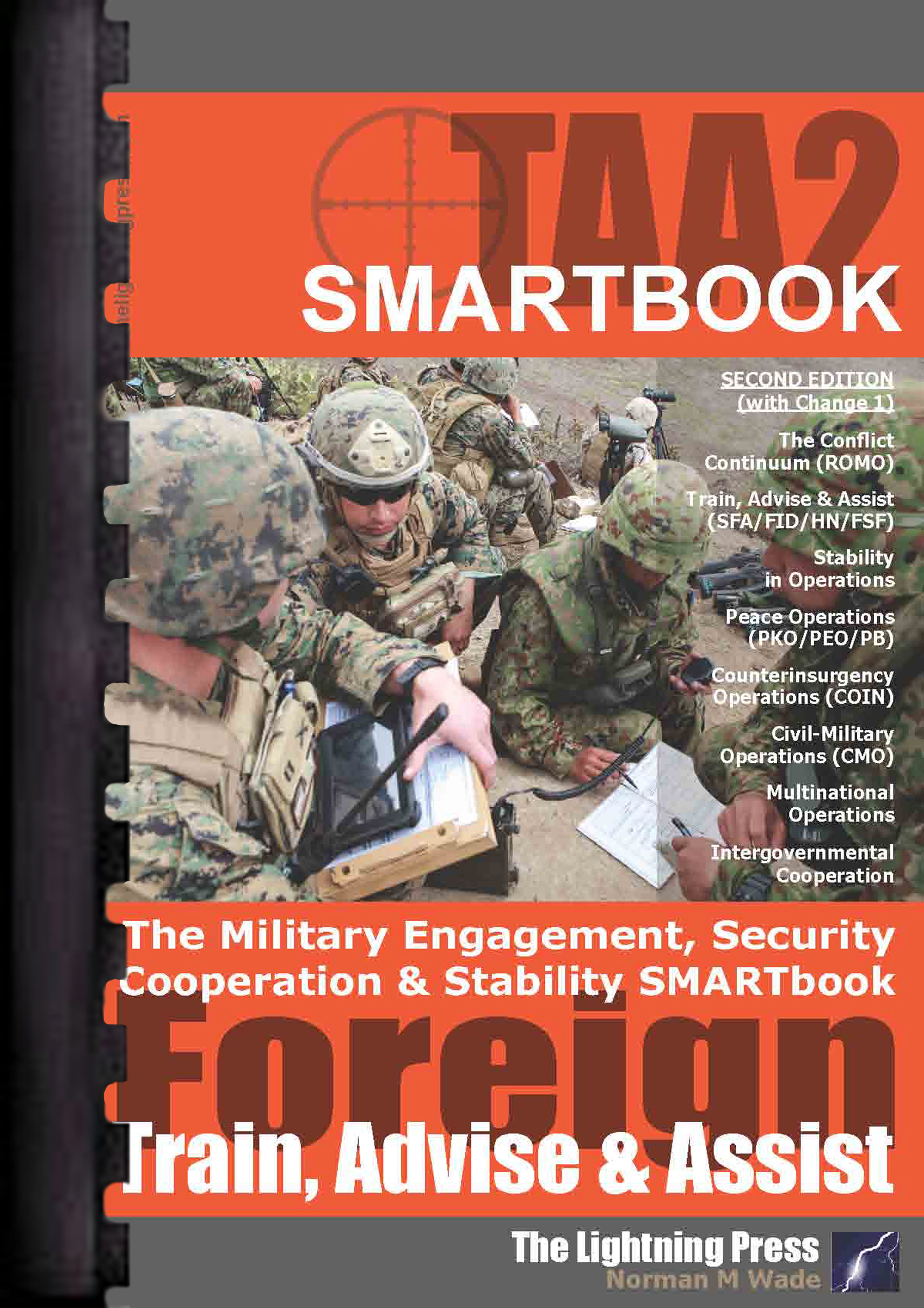

Paperback Edition
Price: $42.95 $36.95

Bundle & Save (Paperback + Digital)
Price: $85.90 $49.95
Train, Advise, & Assist
TAA2: The Military Engagement, Security Cooperation & Stability SMARTbook (with Change 1*) is the re-titled and re-focused second edition of The Stability, Peace & Counterinsurgency SMARTbook. Topics and references include the Range of Military Operations (JP 3-0); Train, Advise & Assist (SFA/FID/IDAD/HN/FSF); Stability Operations (JP & ADRP 3-07); Peace Operations (JP & FM 3-07.3); Counterinsurgency Operations (JP & FM 3-24); Civil-Military Operations (JP 3-57); Multinational Operations (JP 3-16); and Interorganizational Cooperation (JP 3-08).
* Change 1 to TAA2 (Sept 2017) incorporates new material and text edits from JP 3-0 (Jan 2017), JP 3-07 (Aug 2016), JP 3-20 (May 2017), JDN 1-3 (Apr 2013), and JP 3-08 (Oct 2016). An asterisk marks changed pages.
In the complex, dynamic operational environments of the 21st century, significant challenges to sustainable peace and security exist. Sources of instability that push parties toward violence include religious fanaticism, global competition for resources, climate change, residual territorial claims, ideology, ethnic tension, elitism, greed, and the desire for power. These factors create belts of state fragility and instability that threaten U.S. national security.
Throughout U.S. history, U.S. forces have learned that military force alone cannot secure sustainable peace. U.S. forces can only achieve sustainable peace through a comprehensive approach in which military objectives nest in a larger cooperative effort of the departments and agencies of the U.S. Government, intergovernmental and nongovernmental organizations, multinational partners, the private sector, and the host nation.
Military engagement, security cooperation, and stability missions, tasks, and actions encompass a wide range of actions where the military instrument of national power is tasked to support OGAs and cooperate with IGOs (e.g., UN, NATO) and other countries to protect and enhance national security interests, deter conflict, and set conditions for future contingency operations.
Use of joint capabilities in these and related activities such as Security Force Assistance and Foreign Internal Defense helps shape the operational environment and keep the day-to-day tensions between nations or groups below the threshold of armed conflict while maintaining US global influence.
Stability operations are various military missions, tasks, and activities conducted outside the US in coordination with other instruments of national power to maintain or reestablish a safe and secure environment, provide essential governmental services, emergency infrastructure reconstruction, and humanitarian relief.
Peace Operations are crisis response and limited contingency operations conducted by a combination of military forces and nonmilitary organizations to contain conflict, redress the peace, and shape the environment to support reconciliation and rebuilding and to facilitate the transition to legitimate governance.
A counterinsurgency campaign is a mix of offensive, defensive, and stability operations conducted along multiple lines of operations. It requires military forces to employ a mix of familiar combat tasks and skills more often associated with nonmilitary agencies and to be nation builders as well as warriors.
Civil-military operations are a primary military instrument to synchronize military and nonmilitary instruments of national power, particularly in support of stability, counterinsurgency and other operations dealing with asymmetric and irregular threats.
Related Books
Discount sets with this book













